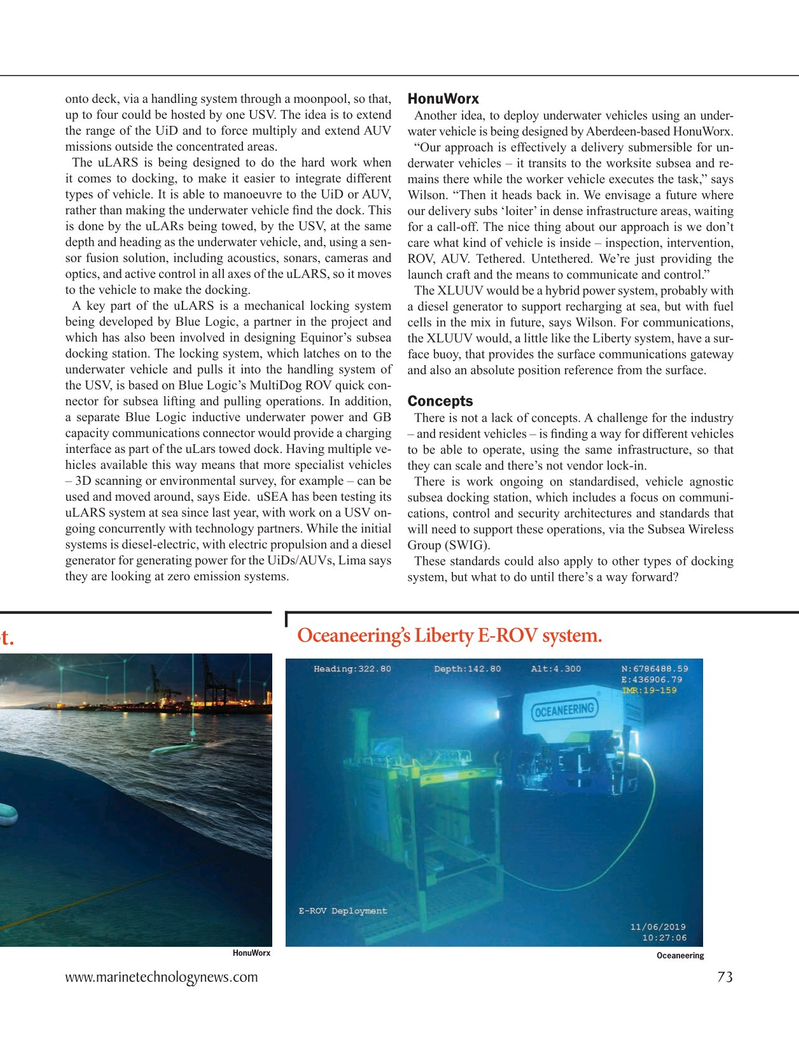
Page 73: of Marine Technology Magazine (September 2021)
MTR100: Focus on 100 Leading Companies, People and Innovations in the Subsea Space
Read this page in Pdf, Flash or Html5 edition of September 2021 Marine Technology Magazine
onto deck, via a handling system through a moonpool, so that,
HonuWorx up to four could be hosted by one USV. The idea is to extend Another idea, to deploy underwater vehicles using an under- the range of the UiD and to force multiply and extend AUV water vehicle is being designed by Aberdeen-based HonuWorx. missions outside the concentrated areas. “Our approach is effectively a delivery submersible for un-
The uLARS is being designed to do the hard work when derwater vehicles – it transits to the worksite subsea and re- it comes to docking, to make it easier to integrate different mains there while the worker vehicle executes the task,” says types of vehicle. It is able to manoeuvre to the UiD or AUV, Wilson. “Then it heads back in. We envisage a future where rather than making the underwater vehicle ? nd the dock. This our delivery subs ‘loiter’ in dense infrastructure areas, waiting is done by the uLARs being towed, by the USV, at the same for a call-off. The nice thing about our approach is we don’t depth and heading as the underwater vehicle, and, using a sen- care what kind of vehicle is inside – inspection, intervention, sor fusion solution, including acoustics, sonars, cameras and ROV, AUV. Tethered. Untethered. We’re just providing the optics, and active control in all axes of the uLARS, so it moves launch craft and the means to communicate and control.” to the vehicle to make the docking. The XLUUV would be a hybrid power system, probably with
A key part of the uLARS is a mechanical locking system a diesel generator to support recharging at sea, but with fuel being developed by Blue Logic, a partner in the project and cells in the mix in future, says Wilson. For communications, which has also been involved in designing Equinor’s subsea the XLUUV would, a little like the Liberty system, have a sur- docking station. The locking system, which latches on to the face buoy, that provides the surface communications gateway underwater vehicle and pulls it into the handling system of and also an absolute position reference from the surface. the USV, is based on Blue Logic’s MultiDog ROV quick con- nector for subsea lifting and pulling operations. In addition,
Concepts a separate Blue Logic inductive underwater power and GB There is not a lack of concepts. A challenge for the industry capacity communications connector would provide a charging – and resident vehicles – is ? nding a way for different vehicles interface as part of the uLars towed dock. Having multiple ve- to be able to operate, using the same infrastructure, so that hicles available this way means that more specialist vehicles they can scale and there’s not vendor lock-in. – 3D scanning or environmental survey, for example – can be There is work ongoing on standardised, vehicle agnostic used and moved around, says Eide. uSEA has been testing its subsea docking station, which includes a focus on communi- uLARS system at sea since last year, with work on a USV on- cations, control and security architectures and standards that going concurrently with technology partners. While the initial will need to support these operations, via the Subsea Wireless systems is diesel-electric, with electric propulsion and a diesel Group (SWIG). generator for generating power for the UiDs/AUVs, Lima says These standards could also apply to other types of docking they are looking at zero emission systems. system, but what to do until there’s a way forward?
Oceaneering’s Liberty E-ROV system. ept.
HonuWorx
Oceaneering www.marinetechnologynews.com 73
MTR #7 (66-79).indd 73 9/22/2021 10:02:54 AM

 72
72

 74
74
